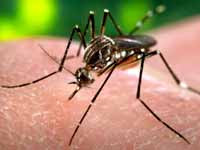BANGKOK (Xinhua) -- The second round of the A/H1N1 influenza outbreak in Thailand has started, Public Health Minister Witthaya Kaewparadai said Thursday.
In the countryside the A/H1N1 virus is spreading in schools as the winter is affecting Thailand, the minister said.
Also, the people's gathering at festivals during the winter time has contributed to the second outbreak of the new flu, Witthaya said.
Hence, public health agencies nationwide have been instructed to strictly implement preventive measures for four months from November to February to curb the outbreak, he said.
These preventive steps include wearing a face mask, often washing hands, avoiding crowded places, and suspending working or class after developing flu-liked symptoms.
Students, working people, elders, and those with chronic diseases will be closely monitored, the minister said.
On Wednesday the Bureau of Epidemiology reported one more death case due to the A/H1N1 contraction, bringing the country's death toll from the new virus to 185.
Thailand had its first two confirmed patients on May 12.
H1N1 Situation in Malaysia
KUALA LUMPUR, Nov 19 (Bernama) -- An Influenza A(H1N1) cluster was reported at the Sekolah Kebangsaan Paya Bungor, Kuantan, last week, Health Ministry director-general Tan Sri Dr Ismail Merican said.
In a statement, he said the district health office had taken the necessary measures to address the matter.
Meanwhile, he said the death toll from H1N1 in the country remained at 77, with no new deaths reported.
Last week, 619 new patients were hospitalised with the influenza-like illness (ILI).
Up to Nov 14, 448 ILI cases were still being treated at 62 hospitals nationwide, he said.
On the global H1N1 situation, Dr Ismail said as at Nov 8, there were 503,536 confirmed H1N1 cases with 6,260 deaths in 206 countries.
He said the transmissions in the northern hemisphere countries such as North America, West Canada, Europe and Asia showed an unusual increase of ILI cases.
The surveillance in those countries showed that the percentage of the H1N1 virus detected was higher compared to seasonal influenza virus.
Earth becoming a disease hot spot : The warming earth is making us sick. Rising temperatures, frequent floods and prolonged droughts are ideal conditions for infectious diseases to spread. "Global warming is fuelling epidemics in areas which are unprepared. We're seeing the emergence of new diseases around the world. Old diseases are also coming back with a vengeance," Climate change has dramatically changing infection trends.
DENGUE DEATH CASES INCREASES BY 65% IN 2010
SAVE THE WORLD - STOP GLOBAL WARMING

Either You're With Me or You're Against Me in Stopping Global Warming!
Global Warming Articles
Let's Go Green & Save The World : Mentor Gemilang
The Truth Hurts - Truth is such a rare thing, it is delighted to tell it.

You can fool some of the people all of the time, and all of the people some of the time, but you can not fool all of the people all of the time.
Most truths are so naked that people feel sorry for them and cover them up, at least a little bit.
Truth always rests with the minority, and the minority is always stronger than the majority, because the minority is generally formed by those who really have an opinion, while the strength of a majority is illusory, formed by the gangs who have no opinion
Let's Go Green - Mentor Gemilang 1 - Visitors from 90 Countries
LATEST NEWS
Are u protected against Influenza A(H1N1)?
Repentance (At Taubah)
We can never be perfect since even prophets have at times made mistakes. Repentance means to abandon one's rebelliousness and arrogance before God and to stop deliberately disregarding His commandments without feeling any shame. Repentance also means to humbly hope for the mercy of God and to fear His judgment while doing the best one can to fulfill divine wishes within the limits of one's human weaknesses.


